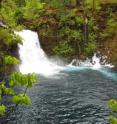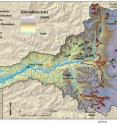Global warming to cut snow water storage 56 percent in Oregon watershed
Related images
(click to enlarge)
A new report projects that by the middle of this century there will be an average 56 percent drop in the amount of water stored in peak snowpack in the McKenzie River watershed of the Oregon Cascade Range -- and that similar impacts may be found on low-elevation maritime snow packs around the world. The findings by scientists at Oregon State University, which are based on a projected 3.6 degree Fahrenheit temperature increase, highlight the special risks facing many low-elevation, mountainous regions where snow often falls near the freezing point. In such areas, changing from snow to rain only requires a very modest rise in temperature.
As in Oregon, which depends on Cascade Range winter snowpack for much of the water in the populous Willamette Valley, there may be significant impacts on ecosystems, agriculture, hydropower, industry, municipalities and recreation, especially in summer when water demands peak.
The latest study was one of the most precise of its type done on an entire watershed, and was just published in Hydrology and Earth System Sciences, with support from the National Science Foundation. It makes it clear that new choices are coming for western Oregon and other regions like it.
"In Oregon we have a water-rich environment, but even here we will have to manage our water resources differently in the future," said Eric Sproles, who led this study as a doctoral student at OSU.
"In the Willamette River, for instance, between 60-80 percent of summer stream flow comes from seasonal snow above 4,000 feet," he said. "As more precipitation falls as rain, there will more chance of winter flooding as well as summer drought in the same season. More than 70 percent of Oregon's population lives in the Willamette Valley, with the economy and ecosystems depending heavily on this river."
Annual precipitation in the future may be either higher or lower, the OSU researchers said. They did calculations for precipitation changes that could range 10 percent in either direction, although change of that magnitude is not anticipated by most climate models.
The study made clear, so far as snowpack goes, that temperature is the driving force, far more than precipitation. Even the highest levels of anticipated precipitation had almost no impact on snow-water storage, they said.
"This is not an issue that will just affect Oregon," said Anne Nolin, a professor in the College of Earth, Ocean, and Atmospheric Sciences, and co-author of the study. "You may see similar impacts almost anywhere around the world that has low-elevation snow in mountains, such as in Japan, New Zealand, Northern California, the Andes Mountains, a lot of Eastern Europe and the lower-elevation Alps."
The focus of this study was the McKenzie River, a beautiful, clear mountain river that rises in the high Cascade Range near the Three Sisters volcanoes, and supplies about 25 percent of the late summer discharge of the Willamette River. Researchers said this is one of the most detailed studies of its type done on a large watershed.
Among the findings of the study: The average date of peak snowpack in the spring on this watershed will be about 12 days earlier by the middle of this century. The elevation zone from 1,000 to 1,500 meters will lose the greatest volume of stored water, and some locations at that elevation could lose more than 80 days of snow cover in an average year. Changes in dam operations in the McKenzie River watershed will be needed, but will not be able to make up for the vast capability of water storage in snow. Summer water flows will be going down even as Oregon's population surges by about 400,000 people from 2010 to 2020. Globally, maritime snow comprises about 10 percent of Earth's seasonal snow cover. Snowmelt is a source of water for more than one billion people. Precipitation is highly sensitive to temperature and can fall as rain, snow, or a rain-snow mix.
The model developed for this research, scientists said, could be readily adapted to help other regions in similar situations determine their future loss of snow water in the future.
Source: Oregon State University
Other sources
- Global warming to cut snow water storage 56 percent in Oregon watershedfrom PhysorgFri, 26 Jul 2013, 14:30:36 UTC
- Global warming to cut snow water storage 56 percent in Oregon watershedfrom Science BlogFri, 26 Jul 2013, 14:00:25 UTC
- Global warming to cut snow water storage 56 percent in Oregon watershedfrom Science DailyFri, 26 Jul 2013, 14:00:12 UTC

